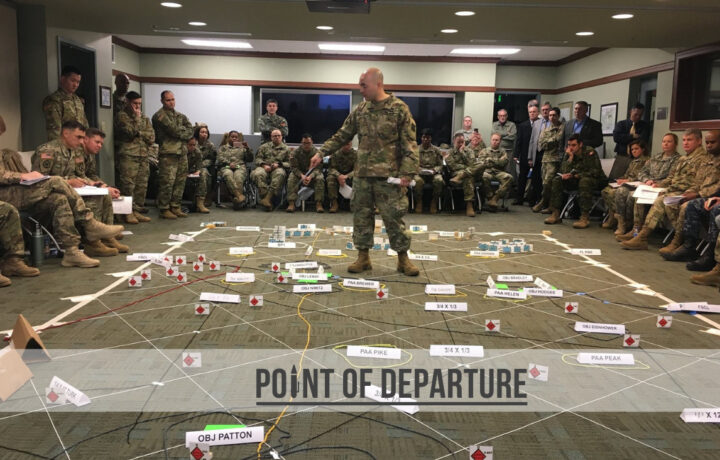Early in my military career, my battalion commander pulled me away from my troops and assigned me to his staff. I was crushed. While I was excited at the prospect of a new challenge and maybe a little proud of the opportunity to take on a staff leadership role, I was also hesitant to leave behind the people with whom my identity was so closely tied. I enjoyed my time with them and genuinely felt an attachment to them. But when the boss calls, “no” isn’t always part of the vocabulary.
The hours were long, the work often endless, and the rewards sometimes seemed elusive. I came to joke that a staff officer’s finest moment came when they found a way to add a fifth block to a “quad chart.” Along the way, I learned that the better I performed my job, the easier life was for the boss. As he mentioned at an event prior to departing for a post-command assignment to the Pentagon, “I never have to worry about you. I give you a task and I know it will get done right the first time.”
In the shadowy world of the staff officer, there is no better compliment.
THE UTILITY INFIELDER
When that staff job led to another, then another, I started to wonder if I would ever escape that world. By the time I reached my mid-career point, I’d led logistics, plans, operations, and personnel staff offices. By my 20-year point, I’d expanded that to include strategic communications and an initiatives group. There were command opportunities mixed among those staff assignments, but the staff always came calling.
As someone later said to me, “You’re a utility infielder. I know I can put you at any position and you’ll play hard every inning.” That’s high praise, but it reflects a lifetime of on-the-job learning and more mistakes than I could list in a single article.
Just like a utility infielder exists to provide flexible options to the manager of a baseball team, a cross-functional staff officer—a broad generalist in many ways—serves to fill capability and capacity gaps in an organization. The more able someone is to move from role to role, the greater their value to the organization as a whole. The utility infielder gives the leadership more options, greater flexibility, and consistent performance.
DANA’S PRINCIPLES
As a senior leader, I’d long since adopted the work ethic and attitude necessary to survive—and thrive—in a staff role. It’s a hard fact that most of us will spend more time in a supporting role than leading an organization, so it helps to accept that fate early enough to make a difference.
Just as we fight from a defined set of principles of war, the staff operates from its own set of principles. But of all the lists of staff principles I’ve seen—or written myself—few hit the mark quite as well as those attributed to retired U.S. Marine Corps Lt. Gen. Mike Dana. In typical Marine fashion, Dana’s principles cut to the chase with little fanfare and no extraneous language. Just the facts.
1. Define the problem before you solve the problem.
The staff tend to be really good at solving problems. But they don’t always take the necessary time to ensure that they’re solving the right problem. Put in the hard analysis up front to be sure that you’ve identified the right problem before launching into a major effort to solve it.
2. How you see the problem can be the problem.
Cognitive bias is the number one enemy of effective problem solving. George Custer’s bias cost the lives of 268 cavalry troopers at Little Big Horn, including his own. Diverse perspectives are essential to problem solving, and even more important to be an effective staff.
3. Don’t admire the problem, solve the problem.
Despite admonitions against doing so, there is still a strong tendency to admire (over-analyze) a problem when a bias toward action is critical. Lean into a problem. Solve a problem. A 90% solution now is better than holding back for a perfect one.
4. Be a problem solver, not the problem.
When it comes to staff officers, Dana breaks them down into two categories: amplifiers (well-meaning people who waste time and effort on detrimental requests for additional information) and synthesizers (people who weave together action on the staff through positive influence). Be part of the solution, not part of the problem.
5. When the boss asks a question, answer the question.
There are two rarely-discussed but critical tasks for any staff officer. One, help the leadership make the best decisions possible with the information available. And two, distill the flood of available information to facilitate decision making. When the boss asks a question, stick to the “so what”—be clear, concise, and correct.
6. Shape the perception space before it is shaped for you.
The better your higher headquarters understands how you’re operating and organizing your resources, the less likely they are to insert themselves into your operations. That begins with a clear, compelling narrative and is reinforced with regular updates.
7. Rolodex, Relationships, and Rehearsals (The 3Rs).
Effective staff work is built on three pillars: one, a wide-reaching network of contacts; two, strong relationships that span—and expand on—that network; and three, a well-developed system of rehearsals to test and operationalize your planning.
Preparation is Key
If there were a final principle, it would be more of a corollary to the fifth one: Answer the boss’s questions before they’re asked. If you’re truly a utility infielder and you’ve been around the bases a time or two, then you should be able to anticipate how the game plays out from a variety of positions. You know what those questions are going to be, so prepare for them in advance. A staff officer’s “finest moment” should come with a look of satisfaction from the boss. Then you’ve done your job well.



